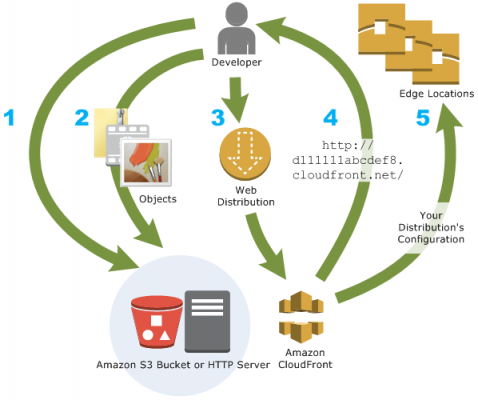- Distributes traffic across multiple edge locations
- It sorts requests so that valid HTTP/HTTPS requests are sent to backend hosts.
- Supports geoblocking, to prevent requests from particular geographic locations.
- Helps to distribute content with less delay and higher speeds of data transfer
- It is a self-service and easily configurable
- It is pay-per-use service
- No long term commitment or minimum fees is charged.
- files are sent to end-users by utilizing edge locations spread globally
- To use,
- For static files, store definitive versions of files in one or more origin servers.
- Register origin servers with Amazon CloudFront through a simple API call.
- Include cloudfront.net domain name, or a CNAME alias that you create, in web application, media player, or website.
- global network of edge locations and regional edge caches are used to speed delivery
- apt for distribution of frequently accessed static content
- supports content that can be sent using HTTP or WebSocket protocols.
- works with any origin server that holds original, definitive versions of content, both static and dynamic.
- For every origin for CloudFront distribution, assign a backup origin to serve traffic if primary fails
- use AWS Management Console to configure and manage CloudFront
- edge locations are worldwide network of data centers called edge locations.
- regional edge caches are located between origin web server and global edge locations
- Geo Restriction feature needs list of countries in which users can access content.
- can create custom error messages for HTTP 4xx and 5xx error responses.

- specify origin servers, like S3 bucket or HTTP server
- upload files to origin servers, called as objects. It can be
- web pages,
- images
- media files
- anything that can be served over HTTP
- create a CloudFront distribution, to tell which origin servers to get files from
- CloudFront assigns a domain name to new distribution
- CloudFront sends distribution’s configuration to all of its edge locations
CloudFront Reporting
Various CloudFront reports in CloudFront console are
- CloudFront Cache Statistics Reports
- CloudFront Popular Objects Report
- CloudFront Top Referrers Report
- CloudFront Usage Reports
- CloudFront Viewers Reports
CloudFront Cache Statistics Reports
- Total Requests is the sum of
- total count of requests for all HTTP status codes (like, 200 or 404)
- total requests for HTTP methods (like GET, HEAD, or POST)
- Percentage of Viewer Requests by Result Type –hits, misses, and errors as a percentage of total viewer requests
- Bytes Transferred to Viewers –total bytes and bytes from misses
- HTTP Status Codes –viewer requests by HTTP status code
CloudFront Popular Objects Report
- lists the 50 most popular objects
- statistics about those objects
- statistics including
- the number of requests for object
- number of hits and misses
- hit ratio
- number of bytes served for misses
- total bytes served
- number of incomplete downloads
- total requests listed as per HTTP status code (like 3xx, 4xx).
CloudFront Top Referrers Report
- report includes top 25 referrers
- the count of requests from a single referrer
- total count of requests from a single referrer as % of total
CloudFront Usage Reports
- Number of Requests –count of HTTP/HTTPS requests from edge locations in specific region in a specific time duration
- Data Transferred by Protocol –total amount of data transferred over HTTP and HTTPS from edge locations in selected region during each time interval
- Data Transferred by Destination–total amount of data transferred over HTTP and HTTPS
CloudFront Viewers Reports
- Devices –types of devices (Desktop or Mobile) users use to access content
- Browsers –name and version of web browsers used to access content
- Operating Systems –name and version of the operating system used when accessing content
- Locations – can see country-wise viewers accessing content
AWS Certified Security - Specialty Free Practice TestTake a Quiz
